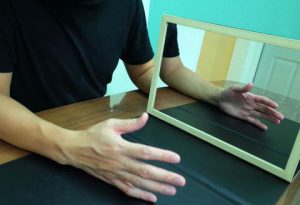How Does Mirror Therapy Work
Mirror box therapy is based on several different theories. For stroke there is moderate quality of evidence that mirror therapy improves recovery of arm function, and evidence for lower limb function and pain. Evidence also exists for patients with complex regional pain syndrome (CRPS) and phantom limb pain. However, it is common for therapy modalities not to have strong evidence as they are difficult to research and there is not much funding in place to support research. The reports from patients tend to be overwhelmingly positive. Nevertheless, mirror therapy is an easy and enjoyable exercise that can be easily carried out at home and should be pain free if you do it the right way.
One theory to explain how mirror therapy is effective in motor re-learning involves “neuroplasticity” which is the “rewiring” of the brain. The mirror creates an illusion of the affected limb to trick the brain into thinking movement has occurred. The visual feedback from the reflection of the unaffected limb helps to drive proprioception in the affected limb. Using this mirror box illusion helps normalize the movement process. It helps re-introduce a normal relationship between physical movement and sensory feedback.

The visual feedback from the mirror helps to stimulate mirror neurons. Mirror neurons were first discovered in monkeys. They respond to actions that are observed in the same way as when the action is actually carried out. For example, watching the optical illusion in the mirror box of your hand moving actually “works” the part of the brain needed to move that hand. Buccino et al. (2001) found a variety of areas in the brain for observation of movements performed with different body parts (hand, mouth, or foot). This suggests multiple mirror neuron systems in the brain,
dependent on the limb with which an action is performed.
Mirror Therapy And Chronic Pain
In relation to pain, mirror therapy can work as a distraction. In chronic pain, the sensorimotor portion of the brain corresponding to the affected limb becomes less active. Pain tends to encourage disuse. As movement of that limb decreases, pain increases and so does the disorganization of the brain. Watching the limb through the optical illusion of the mirror box helps you to experience movement without pain. Through repetition of this, the mapping of the brain can be reversed to be more normal.
Mirror Therapy And Phantom Limb Pain
In phantom limb pain, it has been proposed that the phantom limb feel paralyzed because there is no feedback from it to the brain. This is because while your eyes tell you the limb is no longer there, the nerves that send signals to the limb are still active. This gives the sense that the limb is in a particular position. It is believed that if the brain receives visual feedback that the limb has moved, the phantom limb will become unparalysed and therefore would no longer produce pain.
< Return To Home | Mirror Therapy Box Rehab Kit >